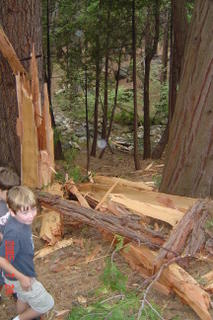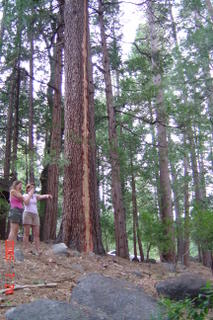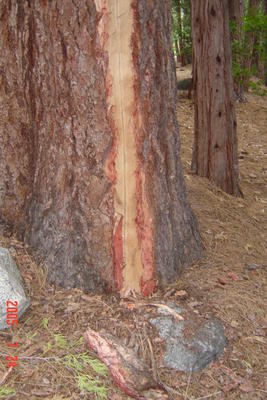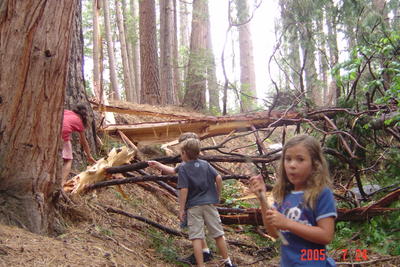Lightning Strike

We were up at my folks cabin in Idyllwild this weekend, and as we were all sitting around minding our own business, a bolt of lightning struck a tree about 70 feet from the cabin and caused the tree to explode. To the left is a picture of the exploded tree. If you look in this distance, you can see some of the debri from the explosion down by the creek.
The tree that exploded was a cedar, but the tree right behind it in this picture, a pine, was the one that actually got hit by the lightning, at least at first. I didn't get a picture of this :(, but the pine tree had score marks going down the side where the lightning traveled just under the surface of the bark, then, about 15 feet from the ground, the score mark stops. We think (actually it was one of the firemen who came by who pointed this out) that the lightning jumped from the pine tree to the cedar, causing the cedar to explode.
Here is another picture of another tree that was also hit. This one was only 30 feet from the house, but didn't explode:

In this tree you can see what I mean about the score marks.
Here is a closeup of one of the score marks:

Both of the trees that have score marks were pines, the one that exploded was a cedar. This leads me to believe that the pine trees carry most of their moisture right under their bark, whereas the cedar must carry a fair amount of moisture deeper in the woody part of the tree. Water conducts electricity, so the lightning is going to follow the wetter parts of the tree to the ground. As the lightning is flowing through the tree, it boils the water, causing it to rapidly expand. In the pine trees, this just caused a strip of bark to be blown off of the tree, but in the cedar, it caused the whole tree to explode.
Note that while this may help the pine tree to survive a lightning strike better, it's also probably the reason that the pine trees have been more susceptible to the bark beetle during the recent drought.

Here is a picture that shows the top part of the tree (the bottom is hiding behind one of the trees on the left). As you can see, it was really only the bottom of the tree that exploded.
As for the experience itself, it was the loudest explosion I have ever heard. I was sitting inside the cabin when it happened, but my first thought was that we were being bombed by airplanes. I was pretty sure that terrorists were involved somehow. Even so, I was pretty protected inside the house. My wife, mother, daughter, four nieces, and one niece's friend were all out on the deck when it happened. I can only imagine what it must have been like for them. Most of them were only about 30 feet from the nearest pine that got hit (but didn't explode), and about 70 feet from the exploding cedar.
